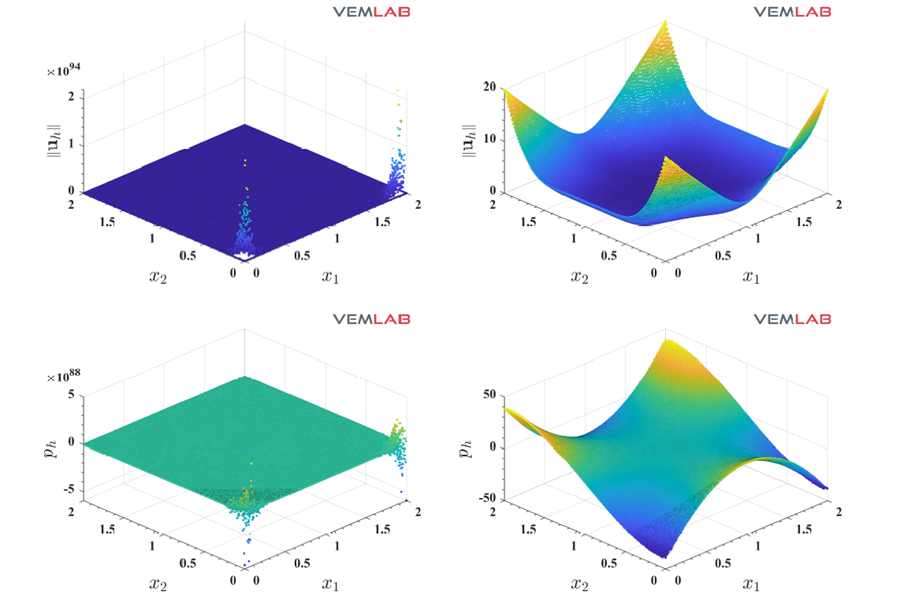2022 – 2025
Principal Investigator: Alejandro Ortiz-Bernardin.
Project funded by ANID-FONDECYT (Grant Nº 1221325)
Nodal integration is a numerical integration scheme for Galerkin weak forms, where the weak form integrals are sampled at the nodes. In this type of scheme, state and history-dependent variables become nodal quantities and thus in nonlinear computations they are tracked only at the nodes. If remeshing is needed, a remeshing strategy using the same nodal set would obviate the mapping of these variables among integration points of the old and new meshes, which, on the contrary, is necessary, for instance, in traditional Lagrangian finite element large deformation simulations with remeshing.
Nodal integration has been used in meshfree and finite element methods but is in the meshfree community where it has attracted great interest as meshfree methods are more suitable for nodal/particle approaches: meshfree approximations rely only on the nodal positions and are less sensitive to mesh distortions. The development of meshfree nodal integration methods has shown that stabilization is required in this type of integration and thus research on stabilization of nodal integration schemes has received great attention. Another reason for the popularity of meshfree nodal integration is that this type of integration is much more efficient than standard Gauss integration and thus it provides huge computational savings for meshfree methods. Even so, the computational cost is still a major drawback in meshfree nodal integration due to the computational burden of meshfree basis functions that includes the solution of an optimization problem and a neighbor search at every integration node. Another drawback is that most of the meshfree approximations are noninterpolatory and thus additional procedures are required to impose Dirichlet boundary conditions. These issues put meshfree methods in a disadvantageous position in comparison with the finite element method, where basis functions computation is effortless, and the approximations are interpolatory.
The virtual element method (VEM) is a generalization of the finite element method that allows using arbitrary polytopal elements. Like in nodal integration, it is equipped with a stabilization procedure. The following properties of the VEM stand out: it can deal with very general meshes formed by elements with an arbitrary number of edges/faces (convex or nonconvex polytopes), and the mesh can even include elements with coplanar edges/faces and collapsing nodes, and non-matching elements. Several studies have reported very robust solutions under mesh distortions and highly nonconvex elements if the elements are not severely distorted. Virtual elements, being a generalization of finite elements, do not have the computational burden of meshfree methods. Its computational cost is comparable to that of finite elements. Since the virtual element method provides approximations that are interpolatory, stiffness matrix stabilization, and robustness under mesh distortion without the computational burden of meshfree methods, we propose to combine nodal integration and the virtual element method into one method that has the benefits of both approaches.
The main objective of this proposal is the development and assessment of a combined nodal integration and virtual element method for simulation of small and large deformation problems in solid mechanics. To combine nodal integration and the virtual element method in a formulation that can handle materials that even exhibit nearly incompressible responses over their deformation or some part of it (e.g., viscoelasticity, elastoplasticity and hyperelasticity), we propose a procedure that is adapted from the node-based uniform strain approach for finite elements, wherein the strain is averaged around nodes from surrounding elements. For situations in which remeshing is required in large deformations, the combined nodal integration and virtual element method will be accompanied with an automatic remeshing technique that preserves the existing nodal set making the remapping of history-dependent variables unnecessary.
The combined nodal integration and virtual element method will be assessed through several benchmark problems in small and large deformation solid mechanics. We expect that the proposed approach, in conjunction with the automatic remeshing, will be a more robust approach than existing nodal integration techniques.
Publications
- A node-based uniform strain virtual element method for compressible and nearly incompressible elasticity.
- A node-based uniform strain virtual element method for elastoplastic solids.
Theses
- Desarrollo de un método de integración nodal para problemas en mecánica de sólidos lineal y no lineal basado en la descomposición del elemento virtual.
- Desarrollo y evaluación de un método de elemento virtual de partículas Lagrangiano para la simulación de flujos con superficie libre. (In progress).
- Desarrollo de plataforma web para la simulación de problemas de mecánica de sólidos en dos dimensiones, utilizando el método de elementos finitos y el método de elementos virtuales. (In progress).
Presentations
- A Node-Based Uniform Strain Virtual Element Method for Elastic and Inelastic Small Deformation Problems.
- A Node-Based Uniform Strain Virtual Element Method For Elastoplastic Solids.
- Desarrollo y evaluación de un método de partículas para el problema de Stokes no lineal.
- Método de integración nodal basado en la descomposición del elemento virtual para plasticidad en grandes deformaciones.

